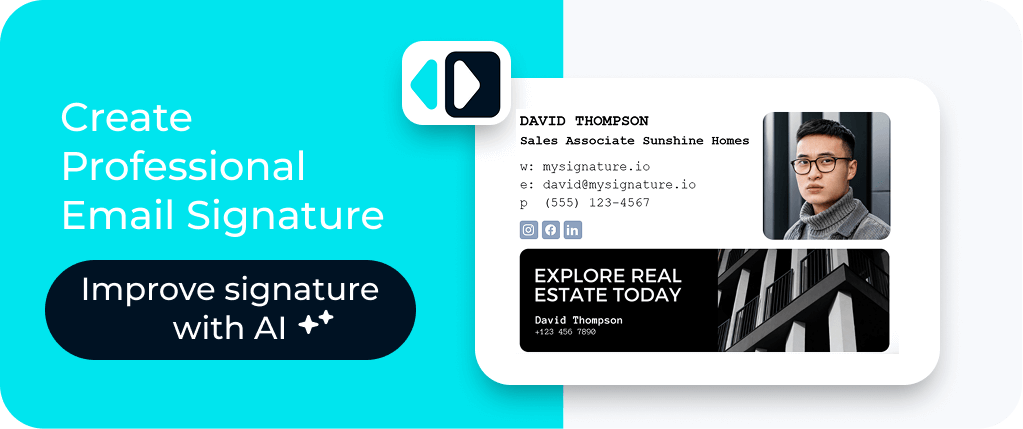The primary purpose of any email is to convey information. Effective professional communication is crucial for business, and writing professional emails is a key element. It needs to follow a logical structure and format that makes it easy for the reader to understand who it's from, what the topic is, and what they need to do next.
And while there's a lot of leeway when you write emails to a friend or family member, a business setting requires a professional email format that's consistent and in line with what the recipient will expect.
But how can you ensure that your formal email format maintain a structure that people can easily understand?
Let's explore what an email design is, how business emails differ from personal ones, and how to properly format them for clear and effective communication.
Contents:
- What Is Email Structure and Format?
- What is the difference between professional email and normal email?
- Key Elements of a Professional Email Structure
- Professional Email Formats You Can Use
- Tips for Writing Effective Professional Emails
- Examples of Professional Email Structure
- Common Mistakes to Avoid in Email Structure and Format
What Is email structure and format?
An email format is the basic personal or business email structure that is consistent in the vast majority of emails. It is a set of unspoken rules that have developed over the decades that email has been in use, which has also shaped the expectations the recipient has when they receive an email in their inbox.
Most people don't think about the format they're using when communicating through email, and that's because the basic structure has become so ingrained in their habits that it doesn't even cross their minds. But when you think about it, there are various email layouts that could theoretically be used, many of which may make the email all but unreadable.
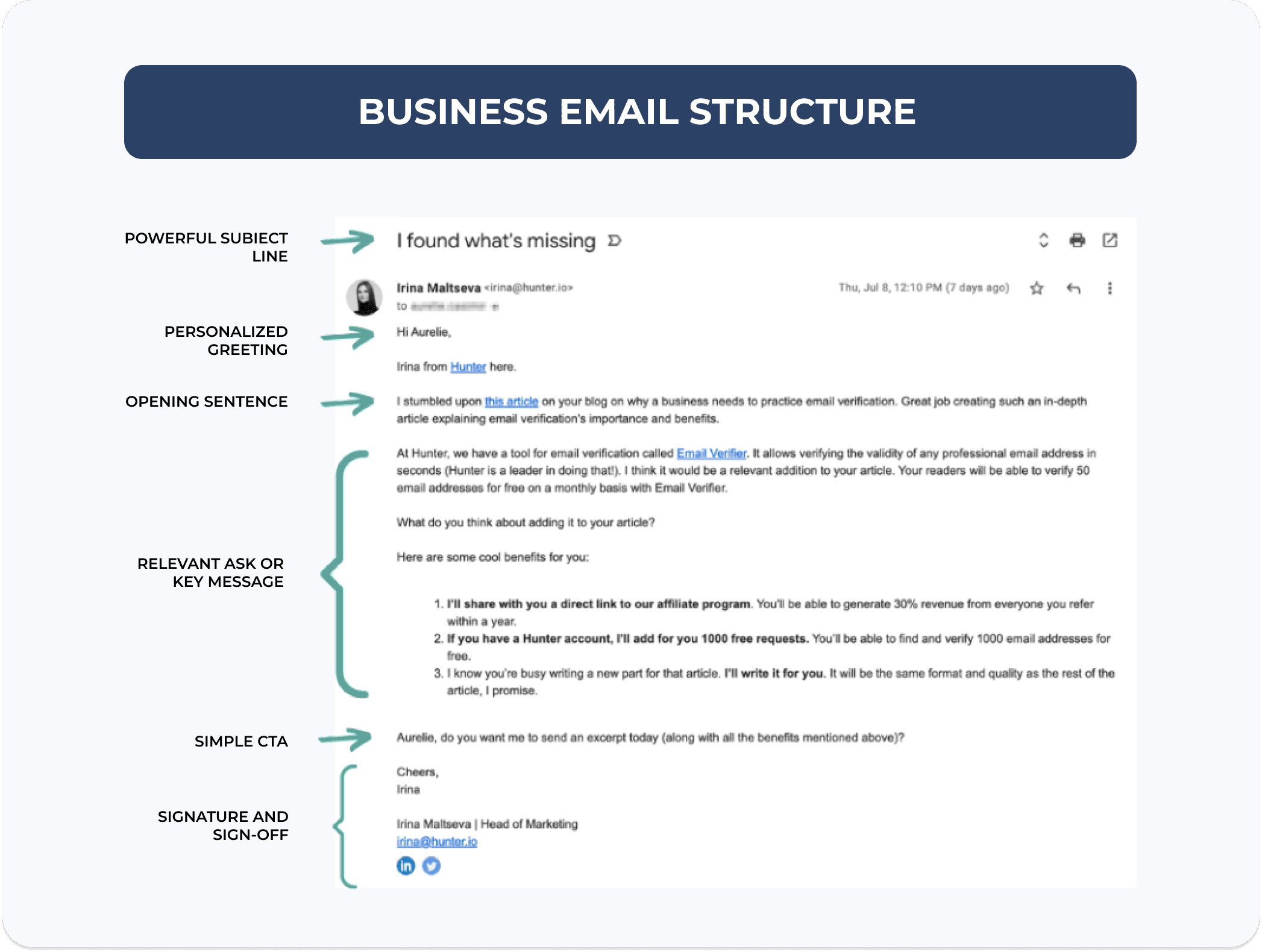
source: Hunter.io
If you were to check your inbox, most emails would likely follow a structure of an subject line, a greeting, the body of your email, a closing line, and a sign-off or an email signature.
However, when you look beyond this basic formula, there are some variations and important considerations when developing a professional signature that suits your brand, goals, and audience. To better understand how to make these decisions, it's essential to first establish the difference between personal and business email communication.
What is the difference between professional email and normal email?
When sending your emails, there's a big difference between a casual "hey, what's up" you'd send to a friend and an email to your boss or client. Even if your message is similar, your format and tone matter if you want to be understood and taken seriously.
For one thing, a skilled email formatting must not waste the recipient's time. You need to make your intentions clear from the first moment of having the reader's attention, and get your message across in a concise, clear, and informative way. The email must also follow specific rules for greetings, sign-offs, and subject lines.
Meanwhile, casual emails can utilize humor, colloquial language, a more liberal sentence structure or grammar, and even emojis or GIFs. At the same time, the subject lines don't have nearly as much importance because the recipient will open the email because of who the sender is and not for the subject.

source: Drip
Here's a quick list of defining qualities that differentiate between professional and casual email formats.
| Starts with a clear email subject line Is sent from a professional email address Has a formal email greeting Uses proper grammar and clear sentence structure Has a formal sign-off |
| Doesn't have hard rules for the subject line Can be sent from quirky or personal email addresses Can be very liberal in the use of grammar and sentence structure Can use emojis, GIFs, and other media Doesn't need to have a formal sign-off for closing your email |
Important note: Even though these differences are essential to understand and apply in many situations, how businesses communicate with their audiences is changing. And because of that, certain industries have become much more daring in their communications, striving to create a brand voice and customer experience similar to how friends communicate over email.
This is especially common for eCommerce brands that need to find a strong voice that gets noticed and creates an appeal for their products. But forward-thinking tech companies are also becoming less formal in their communications, although clarity, a clear message, and a sign-off that drives action remain integral parts of a successful email.
Why both matter in professional communication
Understanding the difference between personal and professional email formats directly impacts how your message is received. In a business setting, a clear structure helps the reader quickly understand your purpose, know what steps to take next, and trust the information you’re providing.
Tone matters just as much. Even a well-organized email can miss the mark if it sounds too casual, too formal, or simply inappropriate for the relationship. The right tone enhances professionalism, fosters connections, and helps avoid misunderstandings.
By blending structure and tone, you ensure your message is clear, intentional, and meets the expectations of the modern workplace.
Key Elements of a Professional Email Structure
At this point, you probably have a pretty good understanding of how a formal email differs from one you'd send to a friend to appear professional. However, when crafting an email consistent with creating a professional email best practices, you may still lack a clear idea of what you should focus on.
If you want to write a official email, an email generator can help you create clear and well-structured messages with the proper format. Below, we'll cover the proper business email template, key considerations, best practices, examples, and common mistakes to avoid.
Subject line
A professional email's subject line is like an article's headline. And that means you need to get good at distilling the main topic, idea and reason for your email into a few words, summarizing what the recipient can expect to see if they open in an informative way. For example, if you want to inform someone of a meeting, don't just write standard formal email opening with the word "Meeting" in your subject line; make it more specific by adding details such as the project name and the date or time.
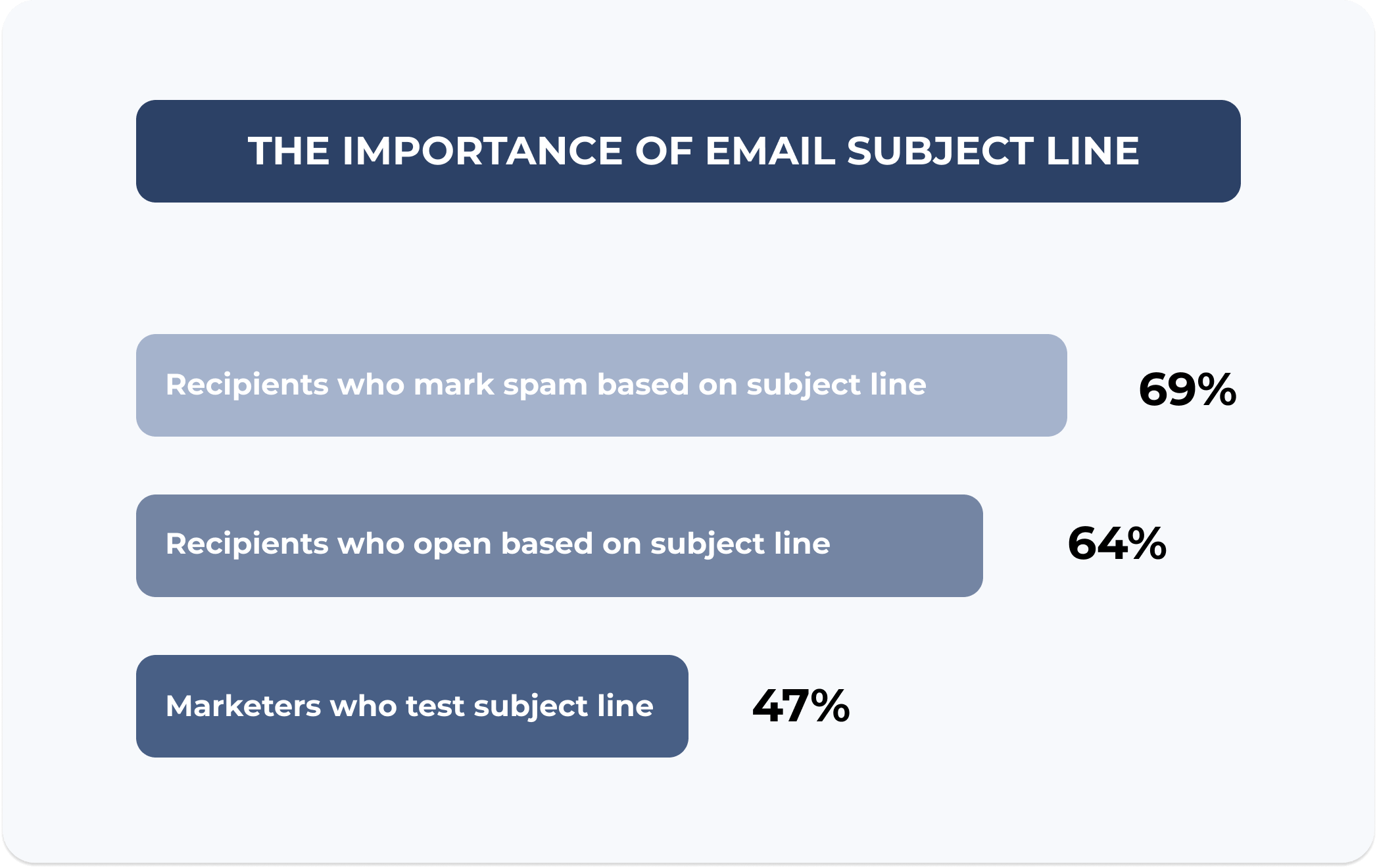
source: Wordstream
Greeting
If you don't want to put off your recipient as soon as they open your email, you need to consider the right way to address and greet them. The choice of salutation can depend on several factors, including how well you know the person and the nature of your relationship. For example, if you're reaching out to someone you don’t know well, start with "Dear," followed by the appropriate title and surname. When communicating with a colleague, a more informal "Hi [Name]" is usually acceptable.
Email body
The body of the email will be the lengthiest part, and the structure will largely depend on how much information you want to convey, what you want to emphasize, and if there are questions or actions you want the recipient to take. That being said, you should strive for clarity above all else, straight to the point, as a business email is often skimmed. That means using clear, short sentences, splitting the text into shorter paragraphs, and even using bullet points to convey the most crucial information. You can use an AI paragraph generator to write a compelling body paragraph about yourself. Just provide your details and select whether you want a professional or casual tone. It will instantly create a paragraph based on your prompt. Make your email easy to read to establish professional relationships and expand your professional network.
Call to action
A call to action, or CTA, is the part of your email that tells the reader precisely what you want them to do next. It’s different from a closing remark, which just politely ends the conversation. The CTA gives clear direction, whether you need them to confirm a meeting, share a document, finish a task, or provide more information. By making your CTAs clear and to the point, you help reduce confusion and avoid unnecessary back-and-forth. It’s a good idea to place the CTA at the end of your email, just before your closing line, so that the next step feels natural and easy to follow.
Closing
The closing remark, often referred to as your sign-off, brings your message to a polite, professional end. This is where you choose a phrase such as “Best regards,” “Sincerely,” or “Kind regards,” depending on the level of formality required. You can add it manually each time, or include your preferred sign-off directly in your email signature for a consistent, automated closing. The goal is simple: finish the email respectfully while maintaining the tone you used throughout.
Email signature
An email signature is the block of information that appears after your sign-off. Unlike a short closing phrase, it acts as your professional ID: usually your name, job title, company, and contact details. Many people also add a logo, headshot, or social media icons so recipients instantly understand who they’re communicating with. A well-designed signature doesn’t just add clarity, it elevates your communication. Today, signatures help build your personal or business brand, provide quick context, and can even promote content, offers, or a link to schedule an appointment.
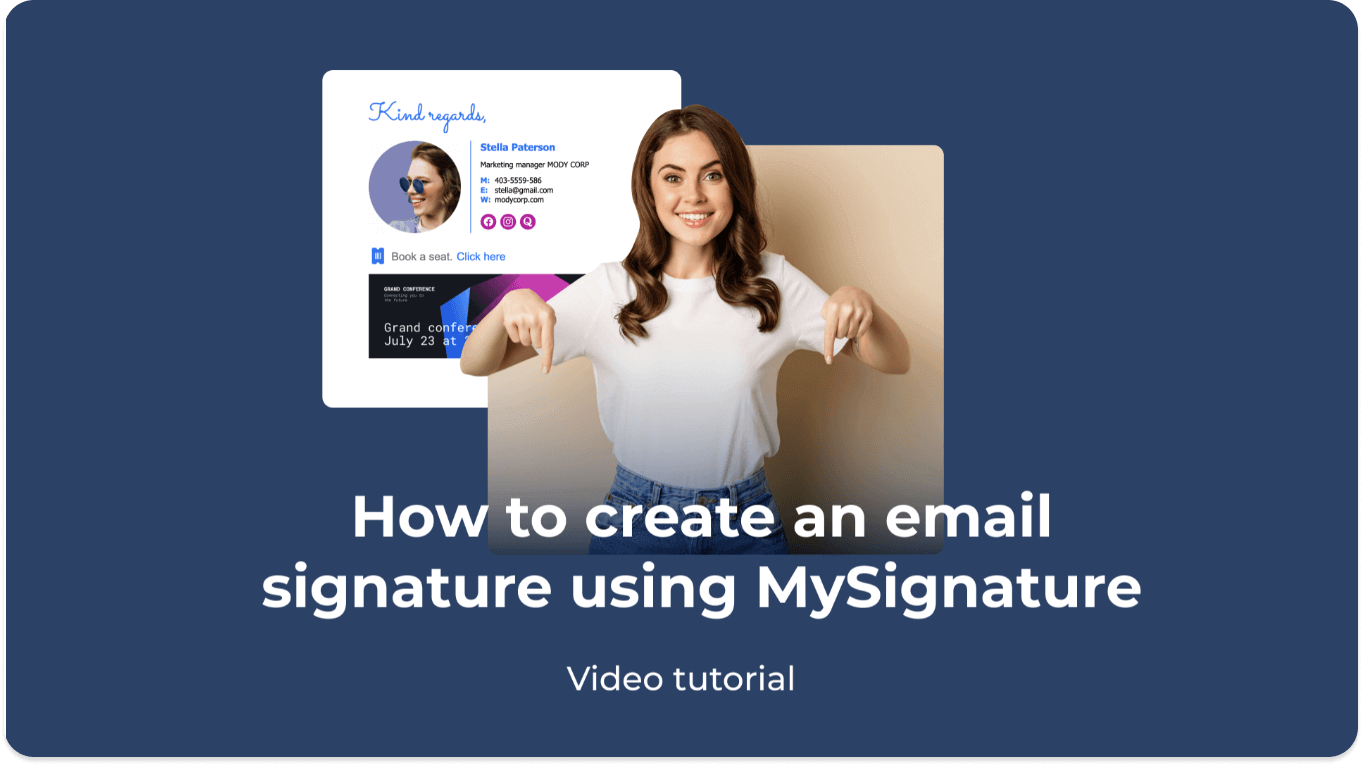
Tools like MySignature make this easy with ready-made templates that let you include essentials such as your phone number, website, social media profile, call to action, professional picture, or even a banner leading to your latest offer or content. This keeps your emails consistent, polished, and trustworthy across every conversation.
Professional Email Formats You Can Use
Choosing the right email format can make your message clearer, more engaging, and better suited to the situation. Even if the structure of a formal email stays mostly the same, the format you choose affects how the content is perceived and how much personality you can include while following proper professional email etiquette.
Formal business email format
A formal business email follows a traditional and structured format, making it ideal for professional situations where clarity and respect are crucial. This approach is particularly effective when communicating with clients, potential clients, supervisors, or anyone with whom you don’t have an established relationship.
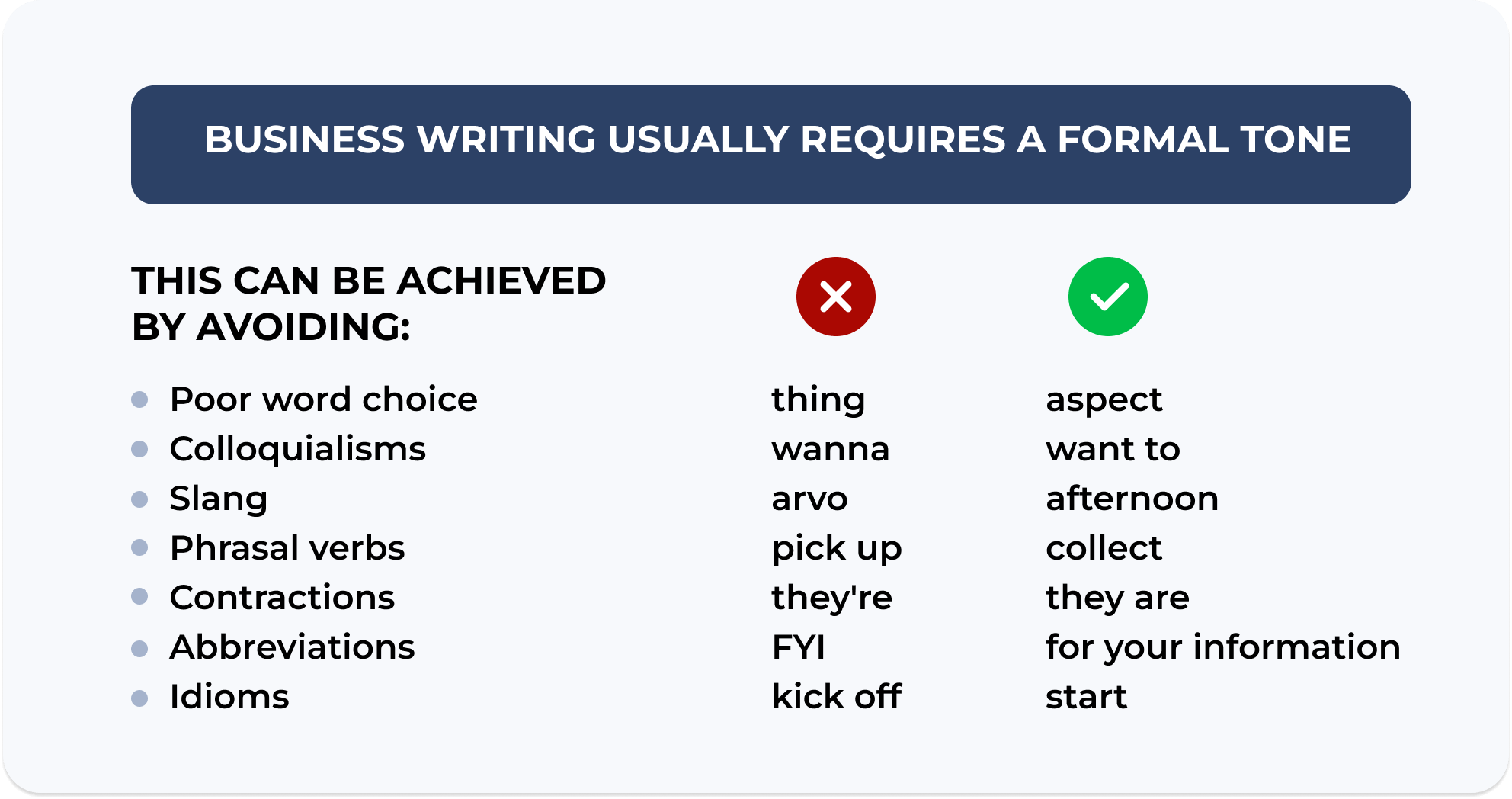
source: YouTube
A typical formal email includes:
- A clear and direct subject line
- A proper greeting that uses titles or last names
- A concise, factual body written in a neutral tone
- A polite sign-off such as “Sincerely” or “Best regards”
- A well-designed email signature
This format avoids slang, casual expressions, emojis, GIFs, and unnecessary filler. The goal is to convey your message clearly and respectfully, allowing the reader to understand your purpose without any room for misinterpretation.
Informal/casual email format
A casual email format offers more flexibility and is appropriate when writing to colleagues you know well, long-term clients, or internal teammates. The structure remains similar, but the tone becomes warmer, lighter, and more conversational.
In a casual email, you can:
- Use a friendly greeting such as “Hi Anna.”
- Incorporate a more relaxed tone and personal touches
- Keep sentences shorter and less formal
- Occasionally include emojis or a bit of humor — if the relationship allows
However, the message should still be organized, easy to read, and professional. Even in a casual format, avoid overstepping boundaries or sounding careless. Think of it as “friendly but polished.”
Plain text vs. HTML email format
Besides tone, you can also choose between two technical formats: plain text and HTML. They exist because email clients, devices, and user needs vary, and you’ll encounter both in your inbox daily.
Plain text emails contain only basic characters with no styling. They’re simple, universally supported, and often used for system alerts, internal messages, or situations where clarity is the priority.
HTML emails support formatting, images, colors, and clickable elements. You’ll see this format in newsletters, onboarding sequences, and branded company emails. It also enables an HTML email signature with styled contact details, icons, and a polished, professional look.
Having both formats ensures emails stay readable, functional, and appropriate for different communication purposes.
Tips for Writing Effective Professional Emails
Crafting emails that are read and understood requires attention to clarity, tone, and readability. Here are key tips to make your messages more effective.
Clarity and conciseness
Get straight to the point. Use short sentences, avoid unnecessary jargon, and organize information logically. Bullet points or numbered lists help highlight key takeaways. Concise means presenting essential details clearly, not leaving anything important out.
Proper grammar and tone
Correct grammar, punctuation, and spelling are essential for professionalism. Always double-check your message to make sure you haven’t left any mistakes or grammatical errors before hitting send. Match your tone to the recipient: formal for clients or senior colleagues, conversational for teammates, but always professional. Avoid slang, emojis, and overly casual language unless they’re appropriate for the relationship.
Formatting for readability
To enhance readability, break your text into shorter paragraphs and incorporate spacing or bullet points. This approach makes it much easier for readers to scan. Be sure to highlight important points as needed, and avoid cramming too much information into dense blocks of text. Good formatting is key; it allows your audience to grasp your message quickly and without frustration.
Examples of Professional Email Structure
Looking at examples of business emails in action can really clarify how the principles we've discussed fit together. The format, tone, and content will change depending on your goal and the recipient, but the basic structure remains the same: a clear subject line, a fitting greeting, a concise body, and a professional closing.
Here are three typical examples to demonstrate how to structure emails for different situations.
Job application email example
Subject: Application for [Job Title] at [Company Name]
Dear [Mr./Ms. Last Name],
I am excited to apply for the [Job Title] position at [Company Name]. With [X years] of experience in [your field], I have developed skills in [key skills relevant to the role] and have successfully [brief achievement or measurable result].
I am confident that my experience in [specific area] and my ability to [key contribution] would allow me to make a meaningful impact on your team.
I would welcome the opportunity to discuss how my background aligns with your team’s goals. Please find my resume attached for your review, and let me know if we can schedule a time for a conversation.
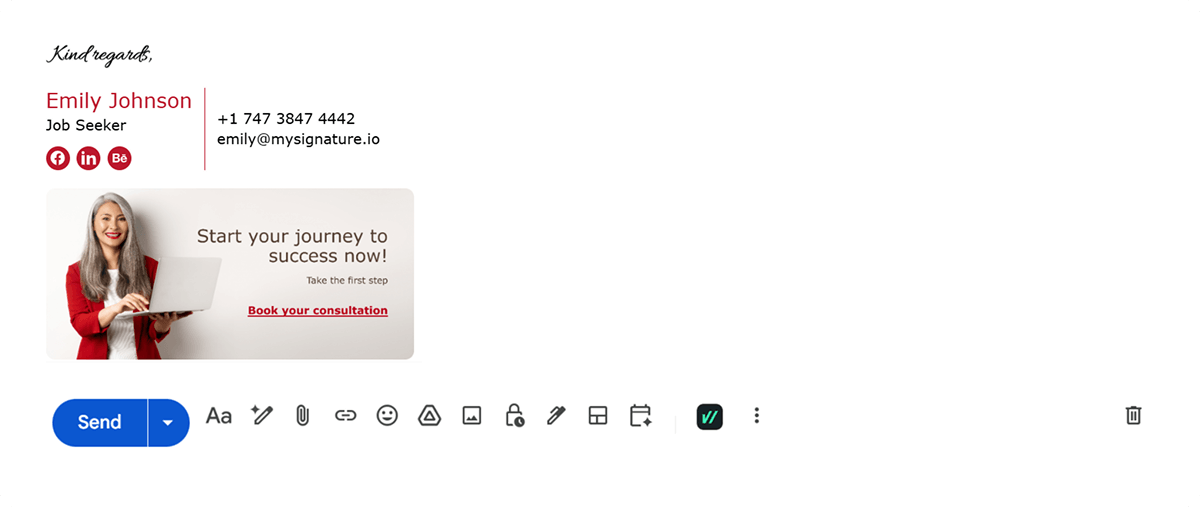
This example demonstrates a concise, professional approach that highlights your qualifications while keeping the email easy to read and actionable.
Business proposal email example
Subject: Proposal for [Project/Service Name]
Dear [Client/Recipient Name],
I hope this email finds you well. I am reaching out to propose [brief description of project or service], which could help [specific benefit or goal for the recipient].
The proposal includes [key points or deliverables], and I would be happy to discuss the details further at your convenience. Could we schedule a meeting next week to review the proposal and answer any questions?
Thank you for your time and consideration. I look forward to your feedback.
Best regards,

This email keeps the message professional, structured, and clear while inviting the recipient to take action.
Follow-up email example
Subject: Follow-up on [Previous Email/Meeting Topic]
Dear [Recipient Name],
I hope you are doing well. I wanted to follow up on my previous email regarding [topic or request] and see if you had any updates or questions.
Please let me know if additional information would be helpful or if we can schedule a time to discuss this further. Your feedback is greatly appreciated.
Thank you again for your time, and I look forward to your response.
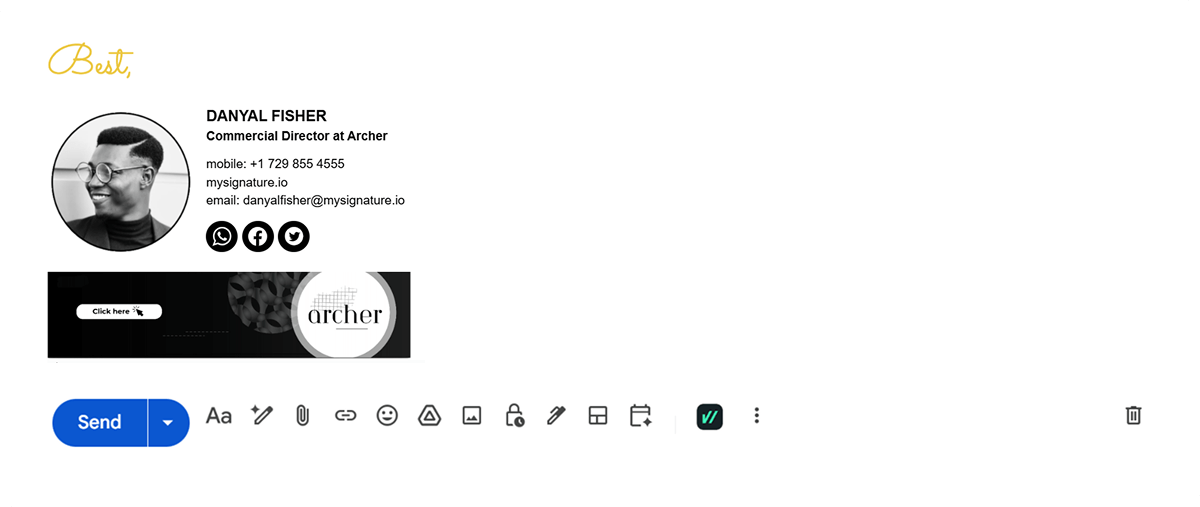
Follow-up emails should be polite, concise, and clear about the next step, helping maintain professionalism while encouraging a response.
Common Mistakes to Avoid in Email Structure and Format
Even people who send thousands of professional emails make occasional mistakes in email formatting and style. But the good news is that when you're aware of the most common blunders, it becomes much easier to stay on top of them and maintain a consistent format for professional email, improving how your emails are received and how well they work.
Here are some of the most common mistakes you should avoid:
- Using a vague subject line. When people start email writing, they typically know what they want to communicate. But that can sometimes result in them jumping straight to the body of the email, which can end up causing the subject line to be neglected. However, it's important to remember if you want people to read your email, it must have a subject line that clearly describes what the email is about. And that is why you should avoid using vague subject lines and keep it professional. It's also not a good idea to use emojis or caps unless you know the person well.
- Starting with a vague salutation. Another common mistake people make with professional emails is using a salutation that's too vague. While you don't want to be too familiar with someone you don't know, going with something like "To Whom It May Concern" is also not great, in this way your email demonstrates too much impersonality and it’s like you could have sent that same email to anyone. Ideally, you should use the recipient's name to show that the email is meant for them. If that's not possible, something like a more familiar "Greetings" might work better.
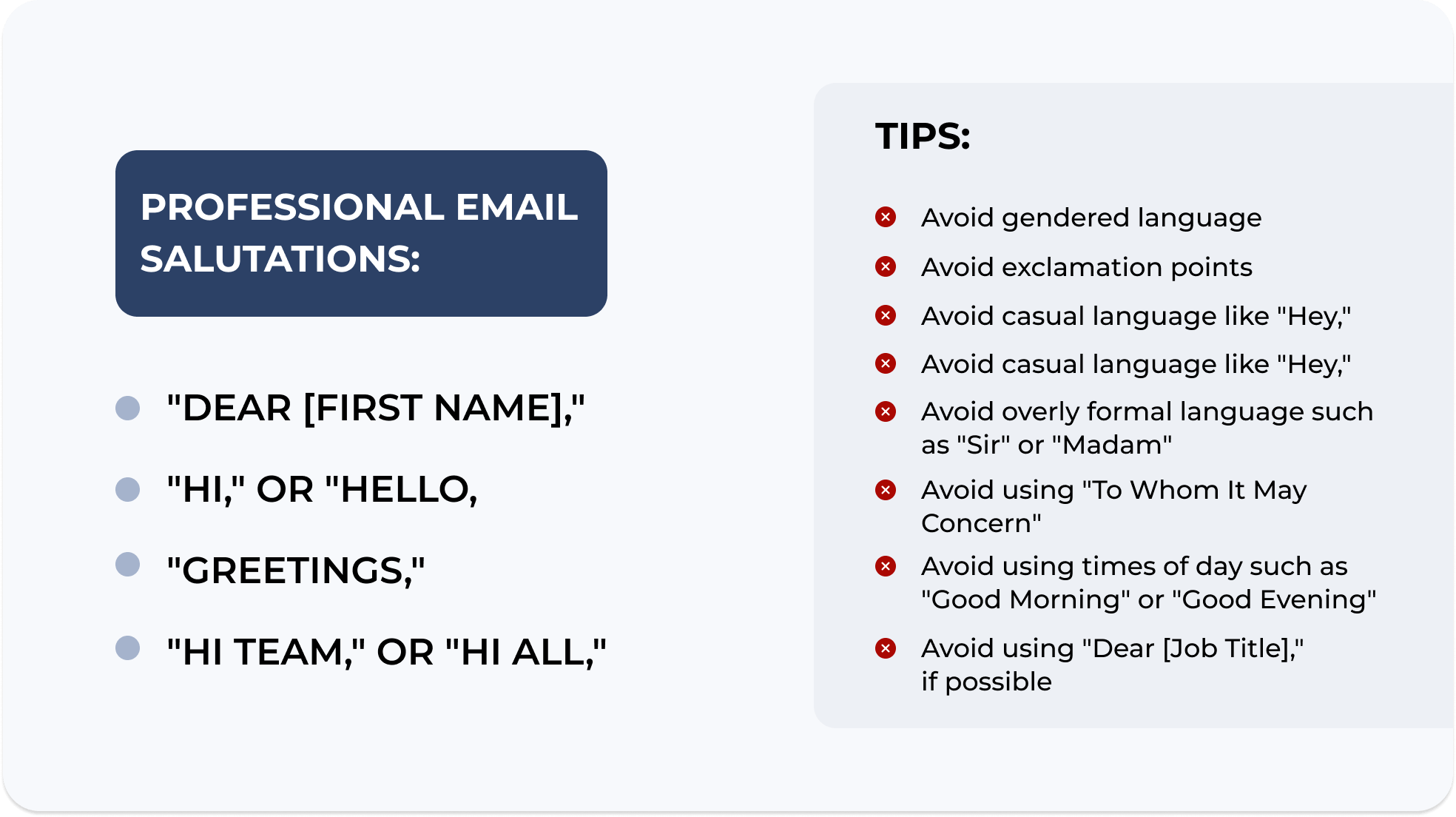
source: Indeed
- Not proofreading. Most people want to send an email as quickly as possible. In business, an email is usually a short distraction before returning to other work activities, so it’s unprofessional if you don't spend a lot of time crafting and editing to make sure your email it's perfect. However, the problem is that grammatical mistakes and typos can instantly diminish your credibility. It's not only unprofessional but shows that you rushed to send the email. The good news is that proofreading an email doesn't have to take more than a minute or two, especially if you use a tool like Grammarly that can quickly spot any issues.
Conclusion
This guide shows you the proper business email format, equipping you with the knowledge and tools to craft impactful emails that leave a positive impression. Whether you’re writing cover letters, thank-you emails, follow-ups, cold emails, or job application messages, understanding how to format your professional emails effectively is key to being seen as a skilled communicator.
One of the easiest ways to supercharge your professional emails is with a well-designed email signature. Instead of a generic sign-off, a polished signature tells a story about who you are, provides essential contact information, and strengthens your personal or business brand.
With MySignature, creating the perfect signature is simple. Whether you’re an entrepreneur, business owner, teacher, or lawyer, you can choose from specialized templates, fill in your details in minutes, and ensure your signature displays correctly across all devices — for yourself or your entire team. This small addition can instantly elevate every email you send and leave a lasting impression.
